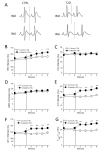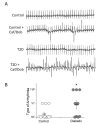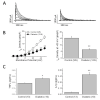Molecular and Electrophysiological Role of Diabetes-Associated Circulating Inflammatory Factors in Cardiac Arrhythmia Remodeling in a Metabolic-Induced Model of Type 2 Diabetic Rat
- PMID: 34202017
- PMCID: PMC8268936
- DOI: 10.3390/ijms22136827
Molecular and Electrophysiological Role of Diabetes-Associated Circulating Inflammatory Factors in Cardiac Arrhythmia Remodeling in a Metabolic-Induced Model of Type 2 Diabetic Rat
Abstract
Background: Diabetic patients have prolonged cardiac repolarization and higher risk of arrhythmia. Besides, diabetes activates the innate immune system, resulting in higher levels of plasmatic cytokines, which are described to prolong ventricular repolarization.
Methods: We characterize a metabolic model of type 2 diabetes (T2D) with prolonged cardiac repolarization. Sprague-Dawley rats were fed on a high-fat diet (45% Kcal from fat) for 6 weeks, and a low dose of streptozotozin intraperitoneally injected at week 2. Body weight and fasting blood glucose were measured and electrocardiograms of conscious animals were recorded weekly. Plasmatic lipid profile, insulin, cytokines, and arrhythmia susceptibility were determined at the end of the experimental period. Outward K+ currents and action potentials were recorded in isolated ventricular myocytes by patch-clamp.
Results: T2D animals showed insulin resistance, hyperglycemia, and elevated levels of plasma cholesterol, triglycerides, TNFα, and IL-1b. They also developed bradycardia and prolonged QTc-interval duration that resulted in increased susceptibility to severe ventricular tachycardia under cardiac challenge. Action potential duration (APD) was prolonged in control cardiomyocytes incubated 24 h with plasma isolated from diabetic rats. However, adding TNFα and IL-1b receptor blockers to the serum of diabetic animals prevented the increased APD.
Conclusions: The elevation of the circulating levels of TNFα and IL-1b are responsible for impaired ventricular repolarization and higher susceptibility to cardiac arrhythmia in our metabolic model of T2D.
Keywords: arrhythmia; cytokines; insulin resistance; potassium current; torsade de pointes.
Conflict of interest statement
The authors declare no conflict of interest.
Figures






Similar articles
-
Kv1.3 Channel Blockade Improves Inflammatory Profile, Reduces Cardiac Electrical Remodeling, and Prevents Arrhythmia in Type 2 Diabetic Rats.Cardiovasc Drugs Ther. 2023 Feb;37(1):63-73. doi: 10.1007/s10557-021-07264-1. Epub 2021 Oct 8. Cardiovasc Drugs Ther. 2023. PMID: 34623540 Free PMC article.
-
Metformin Reduces Potassium Currents and Prolongs Repolarization in Non-Diabetic Heart.Int J Mol Sci. 2022 May 27;23(11):6021. doi: 10.3390/ijms23116021. Int J Mol Sci. 2022. PMID: 35682699 Free PMC article.
-
ATF3 expression in cardiomyocytes preserves homeostasis in the heart and controls peripheral glucose tolerance.Cardiovasc Res. 2017 Feb;113(2):134-146. doi: 10.1093/cvr/cvw228. Epub 2016 Nov 7. Cardiovasc Res. 2017. PMID: 28082453
-
Reduction in Kv Current Enhances the Temporal Dispersion of the Action Potential in Diabetic Myocytes: Insights From a Novel Repolarization Algorithm.J Am Heart Assoc. 2016 Feb 19;5(2):e003078. doi: 10.1161/JAHA.115.003078. J Am Heart Assoc. 2016. PMID: 26896476 Free PMC article.
-
Electrical Features of the Diabetic Myocardium. Arrhythmic and Cardiovascular Safety Considerations in Diabetes.Front Pharmacol. 2021 Jul 8;12:687256. doi: 10.3389/fphar.2021.687256. eCollection 2021. Front Pharmacol. 2021. PMID: 34305599 Free PMC article. Review.
Cited by
-
Progression of electrophysiological impairments in diabetic cardiomyopathy and intervention using Enicostemma axillare.Turk J Biol. 2024 Nov 4;49(2):148-161. doi: 10.55730/1300-0152.2733. eCollection 2025. Turk J Biol. 2024. PMID: 40365100 Free PMC article.
-
Mesenchymal Stem Cell Therapy in Diabetic Cardiomyopathy.Cells. 2022 Jan 11;11(2):240. doi: 10.3390/cells11020240. Cells. 2022. PMID: 35053356 Free PMC article. Review.
-
Astaxanthin mitigates diabetic cardiomyopathy and nephropathyin HF/HFr/STZ diabetic rats via modulating NOX4, fractalkine, Nrf2, and AP-1 pathways.Sci Rep. 2025 Jun 20;15(1):20199. doi: 10.1038/s41598-025-06263-8. Sci Rep. 2025. PMID: 40542047 Free PMC article.
-
Associations of Cardiac Ventricular Repolarization with Serum Adhesion Molecules and Cognitive Function in Older Adults: The MIND-China Study.J Alzheimers Dis. 2023;92(1):273-283. doi: 10.3233/JAD-220874. J Alzheimers Dis. 2023. PMID: 36710676 Free PMC article.
-
Effect of hyperglycaemia in combination with moxifloxacin on cardiac repolarization in male and female patients with type I diabetes.Clin Res Cardiol. 2022 Oct;111(10):1147-1160. doi: 10.1007/s00392-022-02037-8. Epub 2022 May 21. Clin Res Cardiol. 2022. PMID: 35596784 Free PMC article. Clinical Trial.
References
MeSH terms
Substances
Grants and funding
LinkOut - more resources
Full Text Sources
Medical

